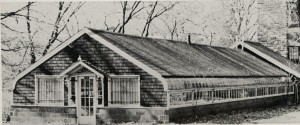When the University of Kansas City opened in 1933 as a privately supported institution it consisted of only three buildings — all part of the former Walter S. Dickey estate — a mansion, a maintenance and boiler building, and a greenhouse.
While most of the academic activities took place in the mansion (now Scofield Hall) the greenhouse was pressed into service as a laboratory building. The East half became the biology lab while the West half became the chemistry lab.
As you can imagine, the greenhouse was often very warm — not always an ideal climate for working with chemicals. In 1981, Dr. Harold Brown, one of the first faculty members in the Chemistry Department, wrote some of his memories of those early days — including a rather explosive incident caused by the warm conditions:
I prepared some Nitrogen Triiodide. This material decomposes explosively when dry and mechanically disturbed, as for example by touching. I collected very small amounts of the wet material on a series of filter papers which I arranged across the front of the lecture desk. They were well separated and I had no reason to anticipate any problems. I left this particular demonstration until near the end of the hour. I wrote the next days assignment on the board. I opened the glass side windows of the greenhouse wide[,] and also the roof windows. I then explained the chemistry involved. I told them the story of how Irving Langmuir as a small boy put the material on the window sill so that his younger brother would be frightened when he touched the material. I explained why the papers were well separated[.] That I would pick them up one at a time and only very mild pops should occur. However, I said if something should cause a louder bang class was dismissed. To my great surprise and consternation, when I picked up the first piece of paper they all went off. I could hear nothing, nor could most of the class. Fortunately we had opened the windows and no damage was done at all. I suspect that this was an illustration of the effect of the considerable heat which we sometimes experienced in the greenhouse on warm days and that the Nitrogen Triiodide was much more easily exploded then normal due to its temperature.



